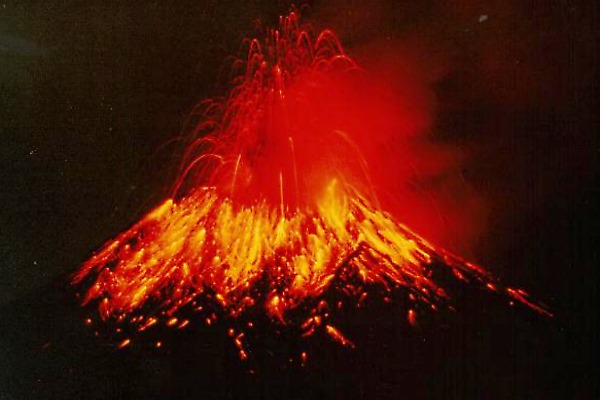
Tungurahua update 7 February 2008
Posted by volcanism in Ecuador, Tungurahua, activity reports, eruptions.
From 11:30 [16:30 GMT] this morning, the activity of the volcano began a new phase of intense eruptive activity. Reports from the Tungurahua Volcano Observatory up to 13:30 [18:30 GMT] indicated that the volcano was producing an emissions column 5 km in altitude with high ash content, and in addition powerful roars have been reported in the vicinity of the volcano. Local authorities have reported falling rocks in the villages on the south-west flank such as Puela and Choglontus. Seismic activity is characterized by a vibration signal or volcanic tremor which, showing a rising pattern for an hour, has returned to moderate levels, but which to date is still continuing. Additionally, satellite images show a hot spot in the crater of the volcano, which indicates the presence of magmatic material on the surface. We must point out that rising patterns of internal tremor activity similar to this have been observed previously in the Tungurahua during major eruptions which have generated pyroclastic flows and large amounts of ash.
The regular daily report (PDF) on the state of the volcano for 7 February 2008, published at 15:00 local time today (20:30 GMT), provides further information on the volcano’s current pattern of activity:
After the intense activity recorded on the night of Tuesday and on Wednesday morning, the volcano entered a period of relative calm, during which the occurrence of three fracture or volcano-tectonic earthquakes and some large explosions stand out. From 11:30 this Thursday an increase in activity was again observed, with the generation of a column reaching 5 km in altitude, and the falling of ash and rock on Choglontus and Puela. Currently, activity is characterized by tremors registering varying intensity associated with constant emissions forming columns reaching above 2 km. […]
The explosions reported in the last few hours are classified as large and were accompanied by heavy cannonades [fuertes cañonazos] that made the windows vibrate in the Tungurahua Volcano Observatory. The eruption of incandescent material falling on the volcano’s flanks up to 1.5 km below the level of the crater was also observed.
This morning there was an emission of ash that reached an altitude of 3 km and was dispersed in a north-western direction: ash fall was reported in Pillate, Choglontus and El Manzano.
The strong emission recorded at 11.30 formed a column that reached up to 5 km altitude and had a large content of ash and rubble that fell on the south-western flank. At the time of this bulletin, the emission is continuing and the column was directed towards the north-west.
The Ecuadorian media continues to report extensively on the effects of Tungurahua’s current activity for local communities. El Mercurio reports that ‘Tungurahua volcano began to roar again today after more than a day of apparent calm’, resulting in the maintenance of the state of emergency in the area and ’the red alert in high-risk areas of the foothills of the colossus, where there have been no reports of casualties’. Hoy Online describes the preparations made for large-scale evacuations, with more than 1400 people so far evacuated from the most high-risk areas, and reports on the plans put into effect by the Ecuador Directorate of Civil Aviation to deal with the possible closure of Quito and Guayaquil airports because of ashfall. Hoy also reports on the effects of Tungurahua’s ashfall in the province of Chimborazo, to the south of the volcano, where yesterday’s feast of Ash Wednesday (Miércoles de Ceniza) took on an extra significance:
One of the areas most affected by the eruption, just as in July and August 2006, was Penipe (Chimborazo). Nearly 224 families (approximately 1000 people) evacuated in the early hours of yesterday [Wednesday 6 February] to the three shelters at Penipe, which have a capacity of about 2000 people. The volcano came as a surprise to everyone, from the inhabitants of these areas to the authorities. However, Juan Salazar, mayor of Penipe, said that the contingency plan they had prepared since last January ‘was a success’. […]
Although there is no official count, Salazar gave an assurance that there were no human casualties, but estimated that 1000 acres of alfalfa and corn crops would be devastated. Streets, roofs and sidewalks have been filled with ash in Penipe, Riobamba, Guano (five minutes from Riobamba) and the areas surrounding the volcano.
El Universo reports that the hydroelectric plant at Agoyán, east of Baños, has been shut down because of Tungurahua’s current activity. It is notable that the authorities in Baños itself are not yet implementing any large-scale evacuation of the town (population 17,000).
InformationSmithsonian Institution Global Volcanism Program - summary information for Tungurahua (1502-80=)
Instituto Geofisico (Escuela Politecnica Nacional) - Geophysical Institute of Ecuador
Informe de actividad Volcán Tungurahua - bulletins from the Instituto Geofísico
News
Una nueva explosión fuerte se registró hoy en el volcán Tungurahua - El Comercio, 7 February 2008 (Spanish)
Tercera explosión pone en alerta a Tungurahua - Hoy Online, 7 February 2008 (Spanish)
Piden ahorro de energía ante emergencia del volcán - El Universo, 7 February 2008 (Spanish)
volcanism.wordpress.com/2008/02/07/tungurahua-update-7-february-2008/

